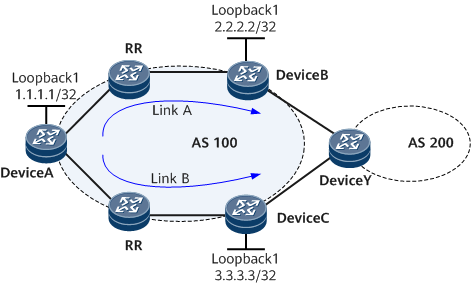BGP Auto FRR
As a protection measure against link failures, BGP Auto fast reroute (FRR) is applicable to networks with primary and backup links. With BGP Auto FRR, traffic can be switched between two BGP peers or two next hops within sub-seconds.
With BGP Auto FRR, if a peer has multiple routes with the same prefix that are learned from different peers, it uses the optimal route as the primary link to forward packets and the sub-optimal route as a backup link. If the primary link fails, the peer rapidly notifies other peers that the BGP route has become unreachable and then switches traffic from the primary link to the backup link.
Application
On the network shown in Figure 1, DeviceY advertises a learned BGP route to DeviceB and DeviceC in AS 100; DeviceB and DeviceC then advertise the route to the corresponding RR, which then reflects the route to DeviceA. In this case, DeviceA receives two routes whose next hops are DeviceB and DeviceC. Then, DeviceA selects a route based on a configured routing policy. Assume that the route sent by DeviceB is preferred. The route received through Link B functions as a backup link.
If a node along Link A fails or a fault occurs on Link A, the next hop of the route from DeviceA to DeviceB becomes unavailable. If Auto FRR is enabled on DeviceA, the forwarding plane then quickly switches DeviceA-to-DeviceY traffic to Link B, which ensures uninterrupted traffic transmission. In addition, DeviceA performs route reselection based on prefixes. Consequently, it selects the route sent by DeviceC and then updates its FIB.
